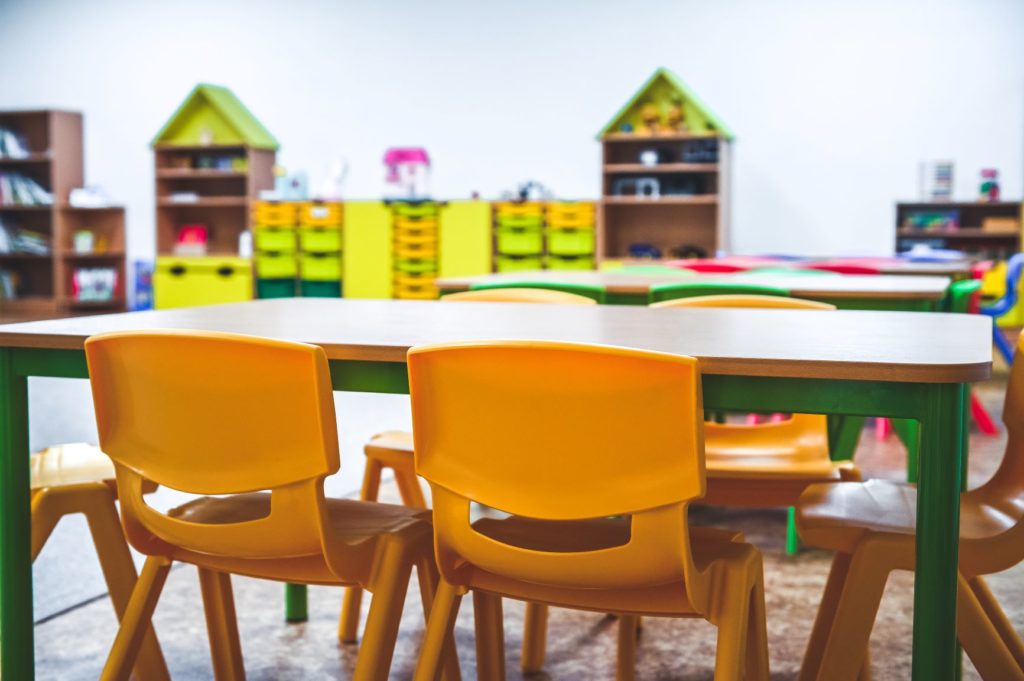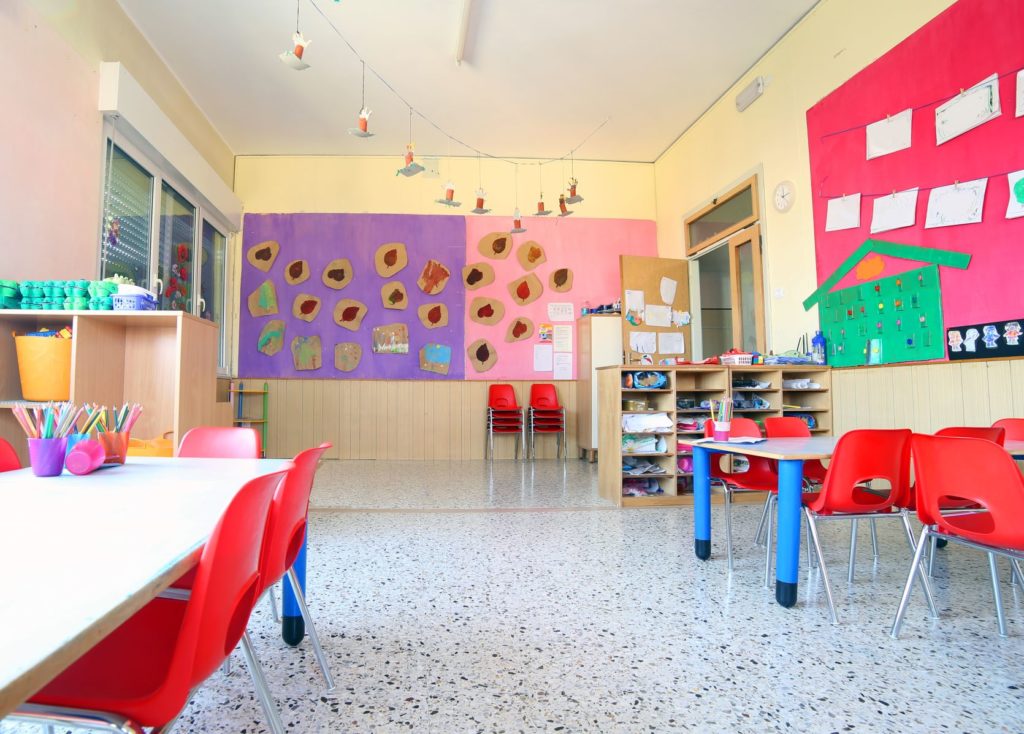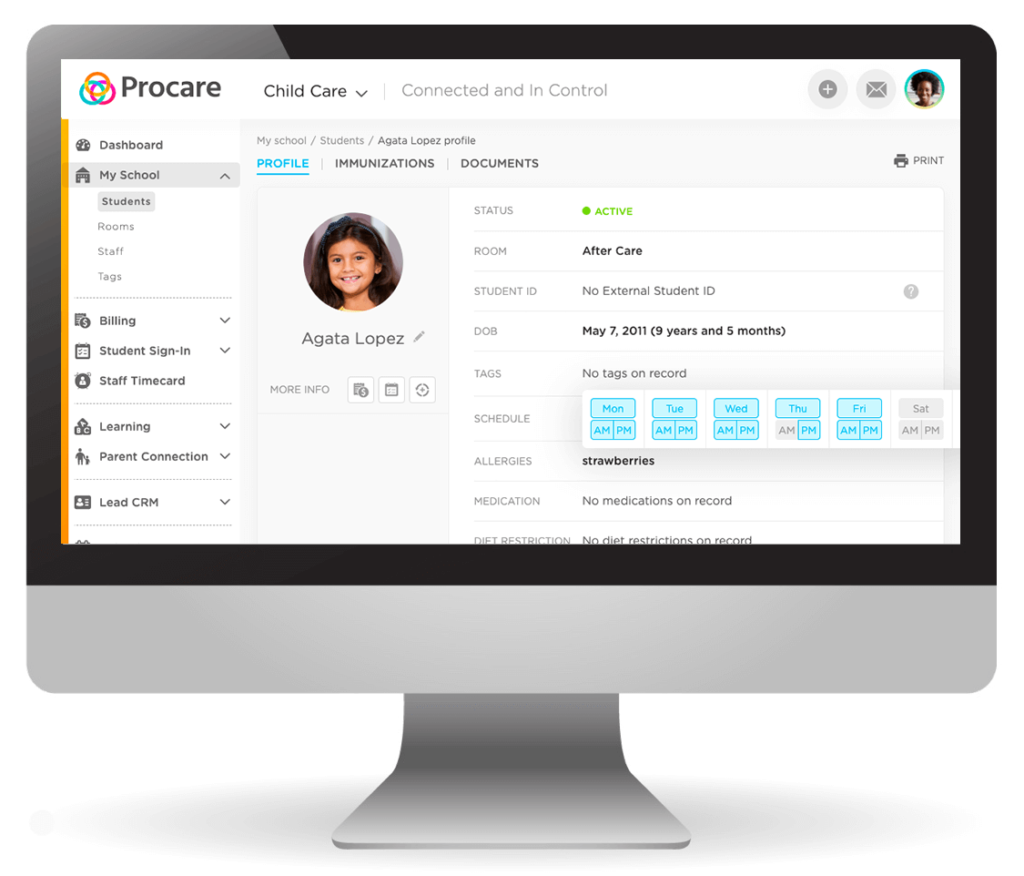
Recently, we looked at optimal child care building design and how it contributes to the best child care outcomes. Today, we’ll take a closer look at classroom decoration and how you can use it to create a well-organized, beautiful child care center that kids, parents and staff will love.
Decorating Your Child Care Center: Why It Matters
Decoration is more than just a “fresh coat of paint,” it’s a vital aspect of the overall design philosophy of your center — giving it personality and transforming chaos into order. A well-decorated child care center is an intentional environment that suits itself to the purposes of both children and adults.
Decoration helps you organize your space, create a comfortable and stimulating atmosphere for kids, and prevent safety hazards. A homelike environment with visual appeal puts both kids’ and adults’ minds at ease, and prepares children for a day of learning and fun.
It’s a good idea to review your classroom setup from time to time to make sure it’s working for you. Signs you may need to reorganize the classroom include:
- Running and chaos in the classroom
- Active play shifting into quiet zones
- Underused classroom areas
- Confusion about the proper place of materials (and resulting mess)
Read on to find out how you can prevent these issues and make the most of your child care space.
Organizing Your Child Care Space

A well-organized space is safer, helps kids develop organizational skills and promotes a harmonious environment. Efficient use of space depends on decorative choices that support the purpose of each area.
One of the most important aspects of classroom organization is defining circulation paths from door to door, to the emergency exit and between each zone. These paths should take kids to their destinations without interrupting activities. Short, curved paths encourage purposeful movement, but long, straight paths can promote running.
Child Care Classroom Zones
Visual and structural boundaries such as flooring changes, color themes and furniture give your classroom an intuitive sense of space, which can be reinforced with written labels and fun posters to designate zones.
Although the exact choice of classroom zones can vary, there are a few zones that should be present in every child care space. Each zone has its own distinct placement, furnishings and decorations that will be most effective.
- Check-in/Check-out Zone
A well-planned check-in zone is both efficient and inviting, and provides a transition point for kids to say goodbye and observe before joining in the day’s activities. Displays of class artwork, staff and student photos, and welcome messages show the personality of your center, while parent seating makes waiting easier. A designated check-in table is a focal point that streamlines drop-offs. Note: While physical distancing guidelines are in place, focus on what supports the highest level of safety, like an app that offers contactless check-in/out. - Cubby Storage Zone
Each child should have their own cubby with storage for items like boots, coats and other personal belongings. Nearby seating lets kids easily dress for going outdoors without getting in each other’s way. Placing this area out of the way of the entrance will help avoid congestion. - Quiet Activity Zone
Quiet activities can include reading, computer use or table toys. These should be separated from rowdier areas so that kids can relax and focus. An ideal spot for a quiet zone is in the furthest corner from the door. Soft colors with comfortable furniture and carpets encourage kids to settle down for quiet time. Make sure there are also one or two spots where kids can find some private time while still within view of staff. - Open Activity Zone
A multi-purpose area for active play should be in a well-lit space with bright colors and resilient surfaces to get kids excited and moving. In active areas, deep, soft landing mats are safe for more physical play. This zone is well-suited for dramatic games, music/dance, arts and crafts, and indoor active play. - Messy Activity Zone
A messy activity zone, such as a sand or water table, should be in an uncarpeted area near a sink for easiest clean-up. It’s also best to keep these activities away from items that can be damaged by water, such as books and electronics. - Age-Specific Zones
- Diapering Area
A diapering area should allow staff to easily watch and move to the rest of the room. Keep a storage unit nearby for diapering necessities. - Crib or Cot Area
A crib or cot area for infants should be isolated from noise and distractions — ideally, in a separate room. Adult seating such as rocking chairs allows holding babies during feeding. - Nap Area
Nap areas for older children should also be in quiet zones, in a separate room if possible. Aim for soft lighting and colors that encourage relaxation. Furnishings can include cots, mats and floor pillows.
- Diapering Area
Decorating Your Child Care Center

The best way to approach decorating your center is from a child’s perspective — including literally getting down to their height! With the child’s-eye-view in mind, you can combine furniture and textiles to create a beautiful, functional classroom.
Choosing the Right Furniture
- Health & Safety
For the safety of your center, all furniture should be sturdy and unable to topple, with rounded corners and cabinets anchored to the wall. Storage for child use should be deep and open-faced, since doors could trap fingers or swing into others. Teacher furniture, on the other hand, needs to allow staff to lock potentially hazardous items out of sight and out of reach. - Color and Aesthetics
Furniture made from natural materials like wood is more hygienic and durable, and contributes a homelike atmosphere to your center. Attractive, friendly colors add visual appeal, but keep in mind that themes with bright primary colors might be a bit too jarring for quiet activity zones. - Quality and Durability
Flimsy furniture is a safety hazard and will need to be frequently replaced, costing more money in the long run. Work with vendors selling high-quality furniture made from non-toxic materials, who provide warranties and replacement parts. Furniture should always be clean and in good condition. - Size & Ergonomics
Furniture should be fitted to children’s size and reach to allow easy tidying and prevent climbing and digging.
Decorating Floors, Windows and Walls
- Windows Coverings and Decals
Blinds and window shades, which should always be cord-free, allow you to adjust the intensity of natural light in your classroom. Decals and other window treatments can add a fun decorative touch while reducing UV exposure. - Wall Hangings and Posters
Wall hangings and posters can be both inspiring and educational. They can contribute to the themes of your learning zones by exposing kids to educational concepts like letters, maps or nature diagrams, or introduce them to the value of art. - Calendar
Every classroom should have a prominently-displayed calendar to help kids keep track of days and anticipate upcoming events. It’s a great route to hands-on learning about time, and it can be a fun way to incorporate aesthetic elements like stickers that display your students’ personalities and interests. - Art Display Wall
This is an indispensable element of any classroom, which gives kids a sense of pride in their work and shows off the unique personality of every class. For an extra special art exhibit, some companies even offer custom murals based on students’ art. - Rugs and Play Pads
Tightly-woven carpets in solid colors, or foam play mats, prevent small objects from getting lost, which can create choking or stepping hazards. A low carpeted platform is well-suited for dramatic play, since it can feel like a “mini-stage” for little ones. - Non-toxic Paints and Wallpapers
With both rugs and wall designs, avoid excessive or cluttered patterns that can cause distractions. It goes without saying to choose non-toxic materials such as lead-free paints and phthalate-free wallpapers.
Creating a Safe & Cozy Space
- Stuffed Animals
A big pile of unique, well-maintained stuffed toys is a source of delight for kids, who can be enticed to settle down for quiet time or naptime by their favorite soft, cuddly friends (note: with pandemic precautions still in place, this might not be feasible right now due to the need to clean regularly). - Cushions
Including ample cushions gives kids the opportunity to stop and collect themselves when they feel the need, which can make your center more relaxing. - Using Bright Colors
Bright colors are fun and enticing, but make sure to choose color combinations that aren’t overstimulating. In napping rooms and other quiet zones, opt for more muted tones. - Decorating for Child Safety
Decorations should be easy to clean and free of dust-collecting nooks and crannies. Use natural, non-toxic materials that are free of phthalates and lead. Synthetic carpets can be full of hazardous chemicals, so search for safety-certified carpeting or avoid carpet entirely in favor of mats, which are also easier to clean.
Optimize Your Child Care Operations with Procare Solutions

Beautiful and functional classroom design helps you make the most of your child care space. Why not complement your decorations with a child care management solution that can enrich every aspect of your center?
Procare’s comprehensive child care software streamlines administrative tasks like child care bookkeeping to save time and reduce costs, while providing activity management to help plan fun learning activities in your newly-decorated space. Our parent engagement app lets families peek inside the classroom with real-time updates and lets you send home professional communications.
Ready to refresh your child care center with more than a new look?
Request a demo today!
Request a Demo
Request a demo and talk with one of our friendly Procare experts to get a tailored child care solution for the unique needs of your business.




